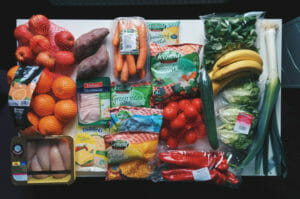
March is National Nutrition Month, making it a perfect time for all of us to look at our eating patterns and decide if it is time to make a few changes.
New Dietary Guidelines for Americans were recently released for 2020 – 2025. These guidelines are designed by policy makers and health professionals to help individuals and their families consume a healthy, nutritionally adequate diet. The Dietary Guidelines for Americans was first published in 1980 and are revised every 5 years. This year they are encouraging all age groups to “Make Every Bite Count”.
Making every bite count is about maximizing the nutrient density of the foods and beverages we consume. Nutrient dense foods and beverages provide vitamins, minerals and other health-promoting components AND have little added sugars, saturated fat and sodium. Basically, nutrient dense foods give you a bigger bang for your buck. Vegetables, fruits, whole grains, seafood, eggs, beans, peas, and lentils, unsalted nuts and seeds, fat-free and low-fat dairy products, and lean meats and poultry—when prepared with no or little added sugars, saturated fat, and sodium—are nutrient-dense foods. Chips, candy, and soda are examples of foods that have a lot of “empty calories” – they are energy dense but low in essential nutrients.
For example, instead of going for bags of chips, for a nutrient dense snack choose nuts, fruit or vegetables. A handful of nuts will give you protein, vitamins and minerals along with some healthy fats. Instead of soda, think about water or mineral water with a little added juice.
Here are some other ways to incorporate more nutrient dense foods into your diet:
- Choose brown rice over white rice.
- Instead of a sour cream on your chili or baked potato, try plain nonfat or low-fat Greek yogurt.
- Choose whole grain bread instead of white bread.
- Instead of mayonnaise, try hummus or an avocado spread.
- Satisfy a sweet tooth with naturally sweet fruit instead of candy and cookies.
- Vegetables pack a real nutrient dense punch. They are rich in vitamins and minerals and most are very low in calories.
It is especially important for older adults to eat a varied nutrient dense diet and to limit foods that provide empty calories. Older adults generally have decreased caloric or energy needs, but increased nutrient needs when compared with younger adults. Nutrient absorption and needs change as we age due to chronic conditions, use of multiple medications and changes in body composition. Although studies show diet quality to be highest among older adults compared to other ages, it is not uncommon for seniors to be malnourished, even if overweight. The good news is that it is never too late to start making every bite count.
The Dietary Guidelines for Americans can be found at https://dietaryguidelines.gov. More information about March for Meals can be found at https://eatright.org/NNM.
For questions or a print out of the key parts of the Dietary Guidelines, please feel free to contact Susy Hymas, Nutritionist and Meals on Wheels Assessment Specialist at [email protected] or (360)746-3756.
